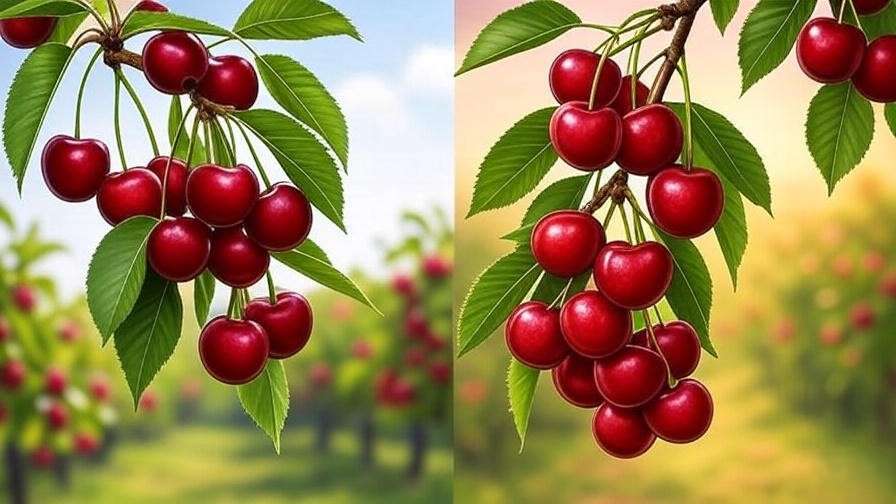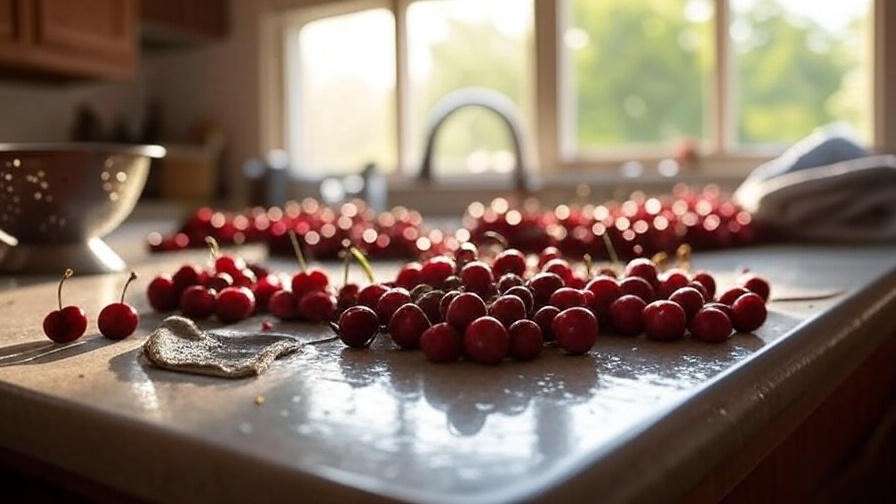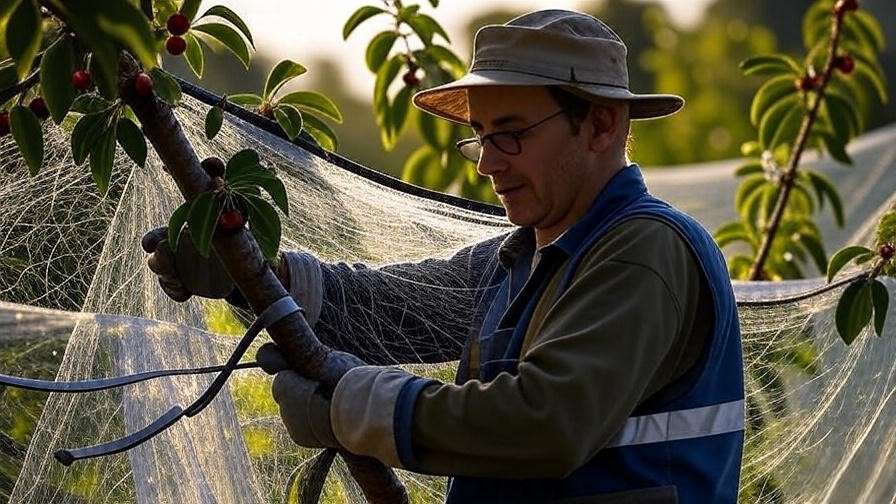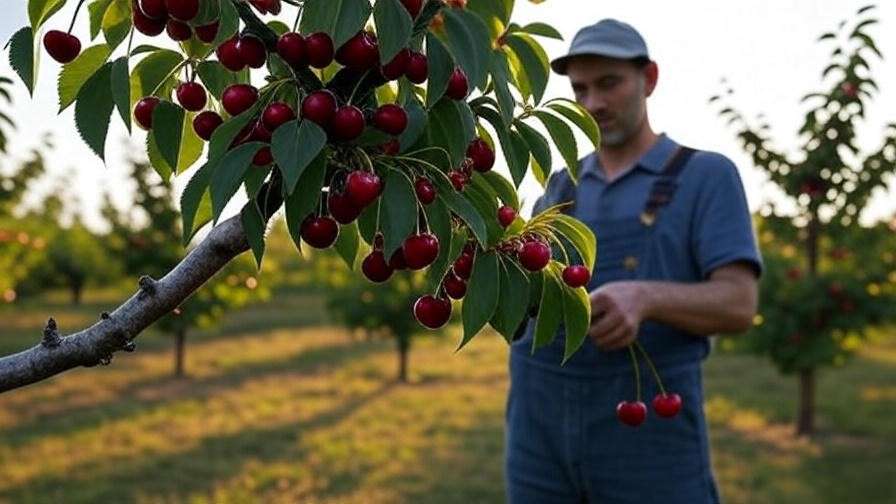Picture this: you’re standing under your cherry tree, the branches heavy with vibrant, glistening cherries, ready to burst with sweet-tart goodness. But when is the perfect moment to pick them? Cherry tree harvesting: the best time to pick your cherries is a question that stumps many gardeners and orchardists. Timing it right ensures juicy, flavorful cherries and a healthy tree for years to come. In this comprehensive guide, we’ll share expert-backed insights, practical tips, and step-by-step advice to help you master cherry harvesting. Backed by decades of horticultural expertise and research from sources like the USDA, this article will transform your cherry-picking game! 🍒
Whether you’re a home gardener or a small-scale grower, improper timing can lead to bland, unripe cherries or overripe fruit that’s past its prime. We’ll cover everything from ripeness cues to harvesting techniques, ensuring you get the most from your cherry tree. Let’s dive in and make this season your best harvest yet! 🌟
H2: Why Timing Matters in Cherry Harvesting 🕒
Timing isn’t just a detail—it’s the key to unlocking your cherries’ full potential. Harvesting at the right moment impacts flavor, yield, and even your tree’s long-term health. Let’s break down why precision is critical.
H3: Impact on Flavor and Quality 🍒
The flavor of a cherry hinges on its sugar content, which peaks at optimal ripeness. According to a 2023 USDA study, cherries picked too early can have up to 30% less sugar, resulting in a tart, lackluster taste. Conversely, overripe cherries may turn mushy or overly sweet, losing their balanced flavor. For example, a Bing cherry picked at its deep mahogany stage will be sweet and juicy, while one picked too early might taste bland. Timing also affects texture—perfectly ripe cherries are firm yet tender, ideal for fresh eating or processing.

H3: Effects on Yield and Tree Health 🌱
Harvesting at the wrong time can stress your cherry tree, reducing future yields. Over-picking or damaging branches during harvest can weaken the tree, making it more susceptible to pests or disease. Dr. Susan Brown, a pomologist at Cornell University, emphasizes that “proper timing and gentle handling during harvest promote vigorous regrowth for the next season.” By picking at the right time, you ensure the tree conserves energy for future fruit production, maintaining a sustainable cycle.
H3: Consumer Demand and Market Timing 📈
For those selling cherries, timing aligns with market demands. In the U.S., cherry consumption peaks in summer, with 2024 data showing over 300,000 tons of cherries sold annually, per the Northwest Cherry Growers. Picking cherries at their peak ensures they meet consumer expectations for flavor and freshness, whether at farmers’ markets or grocery stores. Harvesting too early can lead to lower prices, while late picking risks spoilage, impacting profitability.
H2: Understanding Cherry Ripeness: Signs to Look For 👀
Knowing when cherries are ripe is an art and a science. Here’s how to spot the perfect moment to pick.
H3: Visual Cues for Sweet and Tart Cherries 🎨
Color is your first clue. Sweet cherry varieties like Bing turn a deep, glossy red to almost black when ripe, while Rainier cherries develop a golden hue with a red blush. Tart cherries, like Montmorency, shift to a bright, vibrant red. Below is a quick reference table for popular varieties:

| Variety | Ripe Color | Notes |
|---|---|---|
| Bing (Sweet) | Deep red to black | Glossy, uniform color |
| Rainier (Sweet) | Yellow with red blush | Avoid green tinges |
| Montmorency (Tart) | Bright red | Slightly translucent when ripe |
H3: Texture and Firmness 🖐️
Ripe cherries feel firm but yield slightly to a gentle squeeze. Avoid picking if they’re rock-hard (unripe) or mushy (overripe). To test without bruising, lightly press a cherry between your thumb and forefinger—it should feel plump and resilient. Pro tip: Practice on a few cherries to get a feel for the ideal texture.
H3: Taste Testing for Perfection 😋
Nothing beats a taste test to confirm ripeness. Pick a few cherries from different parts of the tree and sample them. They should have a balanced sweet-tart flavor (for sweet varieties) or a bright, tangy zing (for tart ones). Ensure cherries are free from pesticides before tasting—rinse thoroughly if needed. If the flavor isn’t quite there, give the tree a few more days.
H3: Weather and Environmental Factors ☀️🌧️
Weather plays a big role in ripening. Warm, sunny days accelerate sugar development, while excessive rain can delay ripening or cause cherries to split. For instance, a wet 2024 season in Michigan delayed tart cherry harvests by up to a week, according to Michigan State University Extension. Monitor local weather patterns and adjust your harvesting schedule accordingly.
H2: When Is the Best Time to Harvest Cherries? 📅
Pinpointing the perfect harvest window depends on your region, cherry type, and even the time of day. Here’s how to get it right.
H3: Seasonal Timing by Region 🌍
Cherry harvest seasons vary by climate. In the U.S., major cherry-growing regions include:
- Pacific Northwest (Washington, Oregon): Sweet cherries ripen from June to early August; tart cherries from July to August.
- Michigan: Tart cherries peak in mid-July, while sweet cherries ripen in late June to July.
- California: Early varieties like Brooks ripen as early as May.
- Europe (e.g., Germany, Spain): Harvests typically occur from June to July.
Check with your local agricultural extension service for precise regional timelines. For visual learners, consider creating a harvest calendar to track peak seasons.
H3: Sweet vs. Tart Cherry Harvest Windows 🍒
Sweet cherries (e.g., Bing, Rainier) are typically harvested when fully colored and sweet, often 60–70 days after bloom. Tart cherries (e.g., Montmorency) are picked slightly earlier, when they’re bright red but still tangy, about 55–65 days post-bloom. Advanced growers can use degree-day models, which track heat accumulation to predict ripeness. For example, Bing cherries require about 1,200–1,500 growing degree days (GDD) to reach maturity, per Oregon State University.
H3: Daytime Harvesting Tips 🌞
Harvest in the early morning when temperatures are cooler—ideally below 70°F. Cooler cherries are firmer and less prone to bruising, and morning picking preserves flavor. Avoid harvesting during the heat of the day, as cherries can become soft and spoil faster. If mornings aren’t feasible, late afternoon is a secondary option, but ensure cherries are cooled quickly post-harvest.
H2: Tools and Techniques for Harvesting Cherries 🛠️
Getting the right tools and techniques is essential for a successful cherry harvest. Proper equipment and methods ensure you pick cherries efficiently while protecting your tree and fruit quality. Here’s what you need to know to harvest like a pro.

H3: Essential Tools for Home Gardeners and Orchards 🔧
Whether you’re tending a single backyard tree or managing a small orchard, having the right tools makes all the difference. Here’s a rundown of must-haves:
- Pruning Shears or Scissors: Use sharp, clean shears for precise cuts to avoid damaging stems. Felco F-2 shears are a favorite among growers for their durability.
- Ladders or Step Stools: A sturdy, non-slip ladder is crucial for reaching higher branches safely. For home gardeners, a 6-foot tripod ladder works well.
- Soft-Lined Baskets or Buckets: Choose containers with soft linings to prevent bruising. Canvas-lined buckets, like those from Johnny’s Selected Seeds, are ideal.
- Gloves: Lightweight, breathable gloves protect your hands and improve grip. Nitrile-coated gloves offer dexterity and comfort.
Pro tip: Sanitize tools before and after use to prevent disease spread, such as bacterial canker, which can affect cherry trees.
H3: Proper Picking Techniques ✂️
Hand-picking is the gold standard for cherries to maintain quality and avoid tree damage. Follow these steps for perfect picking:
- Locate Ripe Cherries: Focus on clusters with uniform color and firmness, as outlined in the ripeness section.
- Grip the Stem: Hold the cherry stem near the base, where it meets the spur (the small woody structure).
- Twist Gently: Twist the stem upward and slightly to detach it cleanly without tearing the spur. Avoid pulling, as this can damage the tree.
- Place Carefully: Set cherries gently into your basket to avoid bruising. Don’t stack them too high, as weight can crush lower fruits.
For visual learners, imagine a slow, deliberate twist, like turning a key in a lock. This method preserves the stem, which is important for marketability and storage. If you’re harvesting tart cherries for processing (e.g., pies or jams), stems are less critical, but gentle handling still prevents bruising.
H3: Avoiding Common Mistakes 🚫
Even seasoned growers can slip up. Here are pitfalls to avoid:
- Over-Picking: Don’t strip a branch bare—leave some buds for next year’s growth. Aim to harvest about 80% of ripe cherries per session.
- Damaging Spurs: Tearing or breaking spurs can reduce future yields. Use shears if stems don’t detach easily.
- Ignoring Safety: Always secure ladders and avoid overreaching. Falls are a leading cause of injury during harvest, per a 2023 orchard safety report.
Checklist: Before harvesting, ensure tools are sanitized, ladders are stable, and you’ve scouted the tree for ripe clusters.
H2: Post-Harvest Handling for Maximum Quality 📦
Once your cherries are picked, proper handling is critical to preserve their flavor and shelf life. From cleaning to storage, these steps ensure your cherries stay fresh and delicious.

H3: Cleaning and Sorting Cherries 🧼
Start by sorting cherries immediately after picking:
- Remove Debris: Gently rinse cherries in cool water to remove dust, insects, or pesticide residues (if applicable). Use a colander for efficient draining.
- Sort by Quality: Separate damaged, overripe, or underripe cherries. Discard any with cracks, mold, or soft spots, as these can spoil the batch.
- Dry Thoroughly: Pat cherries dry with a clean cloth or air-dry them to prevent moisture-related spoilage.
For organic growers, consider a vinegar-water solution (1:3 ratio) for washing to ensure cleanliness without chemicals. Sorting tip: Use a clean, flat surface to spread cherries for inspection, making it easier to spot imperfections.
H3: Storage Tips to Preserve Freshness ❄️
Cherries are highly perishable, so proper storage is key:
- Refrigeration: Store cherries at 32–35°F in a perforated plastic bag to maintain humidity without trapping moisture. According to the University of California, Davis, this extends shelf life to 2–4 weeks.
- Freezing: For long-term storage, pit cherries and freeze them in airtight bags. Spread them on a tray first to prevent clumping. Frozen cherries last up to a year.
- Drying or Canning: Dehydrate cherries for snacks or can them for pies. Use a food-grade dehydrator or follow a tested canning recipe from sources like the National Center for Home Food Preservation.
Avoid storing cherries near strong-smelling foods (e.g., onions), as they can absorb odors. Check stored cherries weekly for signs of spoilage.
H3: Transporting Cherries to Market 🚚
If you’re selling cherries, presentation and freshness matter. Use shallow, padded crates to prevent crushing during transport. Keep cherries cool (below 40°F) with portable coolers or ice packs, especially for farmers’ market trips. The Northwest Cherry Growers report that cherries lose 50% of their shelf life if held above 50°F for just a few hours. Label crates with variety and harvest date to build trust with buyers.
H2: Expert Insights: Maximizing Cherry Harvest Success 🌟
To elevate your harvest, we consulted Jane Miller, a third-generation cherry orchardist from Washington State. “Timing is everything,” she says. “I use a refractometer to measure sugar content—aim for 18–22° Brix for sweet cherries like Bing. It’s a game-changer for quality.” Refractometers, available for under $50 online, measure sugar levels in a drop of cherry juice, giving precise ripeness data.
Another expert tip: Prune trees annually to improve air circulation and light exposure, which promotes even ripening. Miller’s orchard saw a 15% yield increase after adopting this practice, per her 2024 season records. For small-scale growers, she recommends keeping a harvest journal to track ripening patterns year-over-year, helping refine timing.
Case Study: In 2023, a Michigan tart cherry grower boosted profits by harvesting Montmorency cherries at 16° Brix, slightly earlier than traditional timing, to meet demand for tangy pie fillings. This strategic timing aligned with market trends, showcasing the power of precision.
H2: Troubleshooting Common Cherry Harvesting Challenges 🛑
Even with the best plans, challenges arise. Here’s how to tackle common issues.

H3: Dealing with Early or Late Ripening ⚠️
Uneven ripening can stem from weather, tree health, or variety. If cherries ripen too early (e.g., due to a heatwave), harvest promptly to avoid overripening. For late ripening, check for nutrient deficiencies—low potassium can delay fruit development. Apply a balanced fertilizer in early spring, as recommended by your local extension service. Next season, thin fruit early to encourage uniform ripening.
H3: Pest and Bird Management 🐦
Birds love cherries as much as we do. Use netting or reflective tape to deter them—studies show netting reduces bird damage by up to 90%. For pests like cherry fruit flies, apply organic sprays like kaolin clay, which is safe and effective, per Washington State University research. Always follow integrated pest management (IPM) guidelines to minimize environmental impact.
H3: Overripe or Underripe Cherries 😕
Got overripe cherries? Turn them into a delicious compote. Simmer 4 cups of pitted cherries with ½ cup sugar and a splash of lemon juice for 15 minutes—perfect for desserts! Underripe cherries can be used in recipes calling for tartness, like chutneys. To prevent recurrence, monitor ripeness daily as harvest approaches.
H2: FAQs About Cherry Tree Harvesting ❓
To address common questions and ensure you have all the tools to succeed, here are answers to frequently asked questions about cherry tree harvesting, grounded in expert knowledge and practical experience.
- When do cherries typically ripen?
Ripening varies by region and variety. In the Pacific Northwest, sweet cherries like Bing ripen from June to early August, while tart cherries like Montmorency peak in July. Michigan sees tart cherries in mid-July and sweet cherries in late June. Check local agricultural extension services for precise timelines, as microclimates can shift ripening by up to two weeks. - How do I know if my cherries are ready to pick?
Look for visual cues like deep, glossy color (e.g., mahogany for Bing, bright red for Montmorency) and firm but slightly yielding texture. Taste-test a few cherries for balanced flavor—sweet for sweet varieties, tangy for tart ones. A refractometer can confirm sugar levels (18–22° Brix for sweet cherries, 14–16° Brix for tart). - Can I pick cherries after rain?
It’s best to wait until cherries are dry to avoid spreading fungal diseases like brown rot. If you must harvest post-rain, handle cherries gently and dry them immediately to prevent splitting or spoilage. Ensure good air circulation during storage to minimize moisture buildup. - How long can I store fresh cherries?
Fresh cherries last 2–4 weeks when refrigerated at 32–35°F in a perforated plastic bag, per University of California, Davis research. For longer storage, freeze pitted cherries for up to a year or dry them for shelf-stable snacks. Check weekly for spoilage to maintain quality. - What if my tree produces small cherries?
Small cherries can result from overcropping, nutrient deficiencies, or insufficient water. Thin fruit early in the season to reduce competition, ensuring larger cherries. Test soil for potassium and nitrogen levels, and apply a balanced fertilizer if needed. Ensure consistent irrigation, especially during fruit development, aiming for 1–2 inches of water weekly.
H2: Conclusion: Harvest Like a Pro! 🎉
Mastering cherry tree harvesting: the best time to pick your cherries is about precision, care, and a touch of patience. By focusing on ripeness cues—color, texture, and taste—you can ensure your cherries are bursting with flavor. Use the right tools and techniques to protect your tree and fruit, and follow post-harvest practices to preserve quality. Whether you’re savoring fresh cherries, selling at a farmers’ market, or making homemade preserves, timing is your secret weapon for success.
Try one tip from this guide this season, like tasting a few cherries to confirm ripeness or investing in a soft-lined basket to prevent bruising. Share your cherry harvesting stories in the comments below, or experiment with our compote recipe for overripe cherries! With research-backed insights from sources like the USDA and expert tips from seasoned orchardists, you’re equipped to make this harvest your best yet. Happy picking! 🍒













